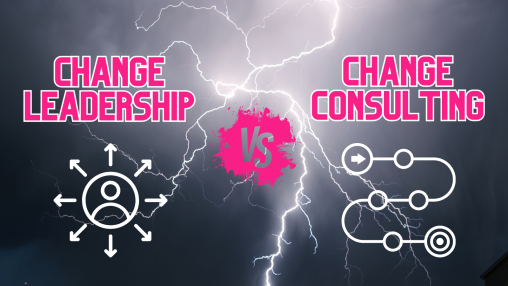
Share this article
Organisations often use two different approaches when implementing change initiatives: change leadership for learning and development and classical change consultants. Both methods aim to help organisations achieve successful change, but they have distinct differences. Change leadership is generally considered more effective in many cases.
Classical change consultants usually come from an outside perspective and offer expert advice and guidance to organisations going through change. They bring specialized knowledge and tools to help identify problems, create strategies, and implement solutions. Their focus is often on process-related aspects like project management, communication plans, and engaging stakeholders.
In contrast, a change leadership approach takes a more comprehensive and internal view. At CLP, we focus on developing change leaders within the organization itself. These individuals take personal responsibility for the change process and motivate others to embrace and drive the transformation. They inspire and guide employees, ensuring that everyone is aligned with the organization’s goals and values. Change leadership places a strong emphasis on people, culture, and the emotional aspects of change.
Here are some reasons why change leadership is often considered more effective:
1. Taking Charge and Staying Committed
Change leaders are usually members of the organization, such as senior executives or influential managers. They know the organization inside out, including its culture, dynamics, and strategic goals. This strong sense of ownership and commitment builds trust and credibility among employees, making them more open to embracing change.
Change leadership coaching specifically targets these senior leaders, providing them with tailored coaching to improve their ability to lead change effectively. This type of coaching focuses on equipping leaders with strategies and skills to handle challenges like managing resistance and involving employees throughout the change process. By closely supporting senior leaders, change leadership coaching aims to enhance their ability to successfully drive organizational change.
2. Matching Cultures Together
Aligning change initiatives with the organization’s culture is crucial. A change leadership approach recognizes the values, norms, and beliefs of the organization. This understanding allows for a tailored change process that fits seamlessly into the existing context. When the change aligns with the organization’s culture, it is more likely to be embraced and smoothly integrated into the organization’s way of doing things.
3. Getting Employees Involved
A change leadership approach understands the importance of engaging employees every step of the way during change. Leaders actively involve employees in decision-making, create channels for feedback and input, and address any concerns or resistance they may have. This participatory approach gives employees a sense of empowerment, builds ownership, and boosts their motivation to support the change.
Strategies for employee engagement help organisations develop comprehensive approaches to involve employees during times of change. This includes planning effective communication strategies, implementing training and development programs, and designing recognition and rewards systems. By prioritizing employee engagement, organisations can create a supportive and inclusive environment that encourages active participation and commitment from employees throughout the change process.
4. Understanding and Managing Emotions
In this change leadership approach, understanding and addressing emotions play a crucial role. Leaders with strong emotional intelligence are able to grasp and respond to the emotional reactions that come with change. This emphasis on emotions creates a supportive and psychologically safe environment, where individuals feel more comfortable adapting and embracing the change.
Leadership development involves creating and implementing programs that specifically target the enhancement of soft skills necessary for effective change leadership. These programs focus on improving communication, collaboration, and emotional intelligence. The goal is to equip leaders with the essential competencies needed to navigate and lead successful organizational change. By prioritizing the development of these important skills, organisations can nurture leaders who excel at driving change and achieving positive outcomes.
5. Making Change Last
Change leadership strives for lasting change by integrating new behaviors, processes, and mindsets into the organization’s culture. Instead of temporary fixes, change leaders concentrate on long-term transformation. This approach ensures that change becomes ingrained in the organization’s DNA, making future adaptations easier and more successful. By emphasizing sustainability, change leadership paves the way for continuous improvement and growth within the organization.
While classical change consultants offer valuable expertise and assistance, a change leadership approach tends to be more effective in implementing change. Change leadership recognizes that successful change goes beyond simply introducing new processes. It involves empowering and inspiring people to take ownership and actively drive the change.
Change leadership takes an internal perspective and places a strong emphasis on people. It acknowledges that for change to truly succeed, individuals within the organization need to embrace and support it. By fostering a people-centric focus, change leadership motivates employees to become active participants in the change process. This approach ultimately leads to more effective implementation and sustainable change outcomes.